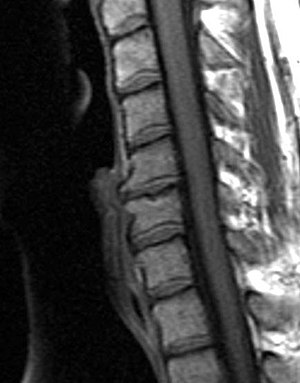Degenerative disc disease
| Degenerative disc disease | |
|---|---|
| Synonyms | degenerative disc disorder |
 |
|
| Degenerated disc, C5-C6 with osteophytes | |
| Classification and external resources | |
| Specialty | Orthopedics |
| ICD-10 | M51.3 |
| DiseasesDB | 6861 |
Degenerative disc disease (DDD) describes the natural breakdown of an intervertebral disc of the spine. Despite its name, DDD is not considered a disease, nor is it progressively degenerative. On the contrary, disc degeneration is often the effect of natural daily stresses and minor injuries that cause spinal discs to gradually lose water as the annulus, or the rigid outer shell of a disc, weakens. As discs weaken and lose water, they begin to collapse. This can result in pressure being put on the nerves in the spinal column, causing pain and weakness.
While not always symptomatic, DDD can cause acute or chronic low back or neck pain as well as nerve pain depending on the location of the affected disc and the amount of pressure it places on the surrounding nerve roots.
The typical radiographic findings in DDD are black discs, disc space narrowing, vacuum disc, end plate sclerosis, and osteophyte formation.
DDD can greatly affect quality of life. Disc degeneration is a disease of micro/macro trauma and of aging, and though for most people is not a problem, in certain individuals a degenerated disc can cause severe chronic pain if left untreated.
The term, degenerative disc disease is a slight misnomer because it is not technically a disease, nor is it strictly degenerative. It is not considered a disease because degenerative changes in the spine are natural and common in the general population.
There is a disc between each of the vertebrae in the spine. A healthy, well-hydrated disc will contain a great deal of water in its center, known as the nucleus pulposus, which provides cushioning and flexibility for the spine. Much of the mechanical stress that is caused by everyday movements is transferred to the discs within the spine and the water content within them allows them to effectively absorb the shock. At birth, a typical human nucleus pulposus will contain about 80% water. However natural daily stresses and minor injuries can cause these discs to gradually lose water as the annulus, or the rigid outer shell of a disc, weakens.
This water loss makes the discs less flexible and results in the gradual collapse and narrowing of the gap in the spinal column. As the space between vertebrae gets smaller, extra pressure can be placed on the discs causing tiny cracks or tears to appear in the annulus. If enough pressure is exerted, it's possible for the nucleus pulposus material to seep out through the tears in the annulus and can cause what is known as a herniated disc.
...
Wikipedia
